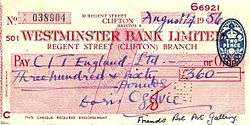Crossing of cheques
A crossed cheque is a cheque that has been marked specifying an instruction on the way it is to be redeemed. A common instruction is for the cheque to be deposited directly to an account with a bank and not to be immediately cashed by the holder over the bank counter. The format and wording varies between countries, but generally, two parallel lines may be placed either vertically across the cheque or on the top left hand corner of the cheque. By using crossed cheques, cheque writers can effectively protect the instrument from being stolen or cashed by unauthorized persons.[1]

Cheques can be open (uncrossed) or crossed.
Open cheque
An open cheque is a cheque that is not crossed on the left corner and payable at the counter of the drawee bank on presentation of the cheque.
Crossed cheque
A crossed cheque is a cheque that is payable only through a collecting banker and not directly at the counter of the bank.
Two parallel transverse lines, with or without any word, are generally drawn on the top left-hand corner of the cheque.
Types of crossing
General crossing
A crossed cheque generally is a cheque that only bears two parallel transverse lines, optionally with the words 'and company' or '& Co.' (or any abbreviation of them) on the face of the cheque, between the lines, usually at the top left corner or at any place in the approximate half (in width) of the cheque.[2] In the UK, the crossing is across the cheque by the person who originally wrote the cheque (the drawer), or it can legitimately be added by the person the cheque is payable to (the payee), or even by the bank that the cheque is being paid into.[3]
Generally-crossed cheques can only be paid into a bank account,[4] so that the beneficiary can be traced.[5]
A crossed cheque on its own does not affect the negotiability of the instrument.
Account payee
Adding a crossing to a cheque increases its security in that it cannot be cashed at a bank counter but must be paid into an account in exactly the same name as that which appears on the ‘payee’ line of the cheque (i.e. the person who has received the cheque, who is legally the “payee” and “holder” of the cheque).
Not negotiable
The words 'not negotiable' can be added to a crossing.
The effect of such a crossing is that it removes the most important characteristic of a negotiable instrument.
Restrictive or special crossings
Where some customary instruction is written between the two parallel transverse lines (constituting crossing of cheque) that may result in imposing certain restrictions on the collecting or paying banker, it is called restrictive crossing. The example is "State Bank of India". In these cases, the respective restrictions mandate to pay the cheque through State Bank of India (acting as collecting banker) only.
Specific bank
A crossing may have the name of a specific banker added between the lines. A cheque with a such a crossing can only be paid into an account at that bank.
The beneficiary bank can add an additional crossing to allow another bank, who are acting as their agent in collecting payment on cheques, to be paid the cheque on their behalf.
Consequence of a bank not complying with the crossing
A bank's failure to comply with the crossings amounts to a breach of contract with its customer. The bank may not be able to debit the drawer's account and may be liable to the true owner for his loss.
References
- Kagen, Julia. "Crossed Check". Investopedia.
- Participation, Expert. "Bills of Exchange Act 1882". www.legislation.gov.uk.
- Participation, Expert. "Bills of Exchange Act 1882". www.legislation.gov.uk.
- Participation, Expert. "Bills of Exchange Act 1882". www.legislation.gov.uk.
- Goosen, W; Pampallis, A; Amelia Van, Der Merwe; Mdluli, L. Banking in the New Millennium. f Juta and Company Ltd. p. 54.